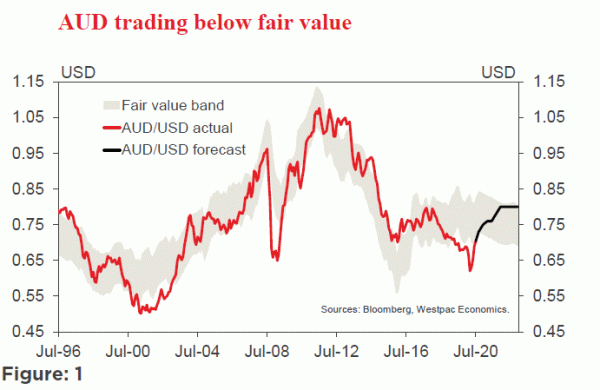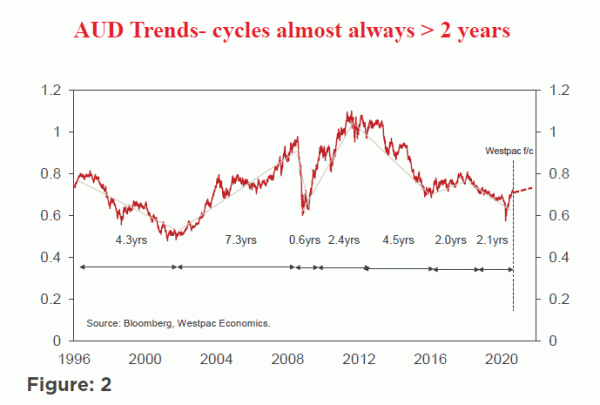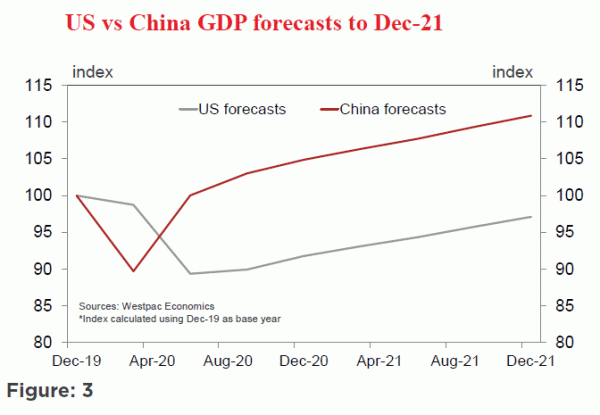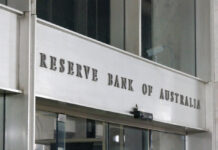On June 5 we sharply raised our forecast profile for the AUD to reach USD 0.72 by end 2020 and USD 0.76 by end 2021. At the time AUD had just dropped back to USD 0.68 but we had decided that the resurgence we had seen since March was likely to be sustained for up to the next two years.
Since then, as can be the case in the forecasting business, the AUD has lifted steadily to USD 0.72 – matching our year-end target.
The case for this momentum to stall is not convincing so we are obliged to bring forward some of the strength through 2021 into the back end of 2020. Recall we expected the AUD to rise by US 4¢ through 2021 to USD0.76.
Equally, we are still comfortable with a strong showing for AUD in 2021.
Accordingly, we have boosted our end 2020 forecast from USD0.72 to USD 0.75 while the 2021 scenario of a further solid boost to AUD remains intact with the resulting forecast for AUD to reach USD 0.80 by end 2021. That represents a US5¢ lift compared to the previous forecast of a US 4¢ increase.
Why do we expect further momentum for AUD through to the end of the year?
Our fair value model continues to signal an undervalued AUD. We currently assess AUD fair value at USD 0.78 and although our base case is that the iron ore price may fall back from USD 120 to USD 110 by year’s end with fair value holding at USD 0.78 it will still be comfortably above our end 2020 target of USD0.75 (see Figure 1).
The risks to the iron ore forecast may well be to the upside. China’s PMI’s remain robust and comfortably above 2019 levels. Chinese steel production and steel prices have lifted significantly. The rise in the iron ore price has not been due to some supply disruption (in fact Brazil has fully recovered its production level from the recent disruptions) but rather strong demand.
With demand prospects remaining buoyant the case for resilient iron ore prices through the remainder of 2020 is credible.
Other factors which are likely to continue to support AUD are the likely ongoing boosts to risk – firm commitments by central banks to support liquidity and demand; ongoing government
stimulus; improving news around developments with vaccines; and Australia’s ongoing current account surplus which we expect to register at $46 bn for 2020 including $10 billion for the December quarter.
The recent evidence is that markets have been looking through adverse developments around the virus – perhaps giving more attention to promising news on the vaccine front.
The New York Times reports 20 Phase 1 projects (testing 10’s of people); 11 Phase 2 projects (testing 100’s) and 8 Phase 3 projects (testing 1000’s) are currently underway globally.
For example, Moderna (US based) has conducted 30,000 tests, at 89 sites and received $1 billion in government research support. Its share price has lifted by 345%.
While there is much cynicism around the Russian and Chinese projects which have received official approval the focus on the success of these projects is likely to be intense.
We expect this vaccine “theme” to be an important factor for markets through 2020 and 2021.
Australian fiscal and monetary policy should also support the AUD.
The Reserve Bank has indicated that the AUD is currently in line with fundamentals – intervening to lower the AUD when it is not overvalued is not considered to be prudent policy.
The expected move to USD0.75 through the remainder of the year will not see the AUD overvalued given our fair value estimate of USD0.78 by year’s end.
Fiscal policy is expected to also remain supportive for the Australian economy.
Current government forecasts underestimate the number of workers who will continue to receive JobKeeper from the December quarter while there will be pressure to boost the payment structures of both JobKeeper and JobSeeker.
The Commonwealth Budget which will be announced on October 6 is likely to be more stimulatory than markets are expecting, boosting growth prospects.
Indeed, we forecast that GDP will lift by 2.8% in the December quarter supported by the reopening of the Victorian economy and ongoing “progress” in the other states.
For 2021 we expect a significant recovery in global growth. From a contraction in 2020 of around 4% we expect global growth to lift to 5% in 2021.
We see relatively more rapid recoveries in the Asian region boosting their currencies which in turn will provide support for AUD.
One of the keys behind our forecasts is the anticipation that actual and expected vaccine success will overshadow any ongoing issues with follow up “waves” of the virus in 2021. If we are correct that AUD will have lifted through the remainder of 2020 to USD0.75 it will begin 2021 with considerable strength. Figure 2, summarises the cycles in AUD since the mid 1990’s. There have been seven significant trends since the mid-1990’s.
Only one was shorter than two years (post GFC collapse in 2009) and China has played the dominant role, explaining the long upswing in early 2000’s (seven years); the post GFC rebound (2.4 years); and the long downswing associated with China’s slowdown around 2013–2016.
This upswing which began in March 2020 and is partly associated with China’s extraordinary recovery from its 10% contraction in the March quarter looks set to last at least two years.
Unlike the aggressive policy stimulus linked to the need to reboot the economy after the GFC, the Chinese authorities are playing a much more disciplined “game” and are well positioned to sustain disciplined domestic stimulus while being prepared to benefit from the global recovery in 2021.
An important aspect of our “story” is a further appreciation of the CNY against the USD.
By end 2021 we expect that activity in China will be 11% above its end 2019 level compared to US which will be 3% below (Figure 3).
The USD has weakened by 10% from its peak and we expect a further 4% weakening, albeit at a slower pace, through 2020 and 2021.
That weakening will reflect a less risk averse economic environment; growth momentum continuing to favour the Asian region; and the extreme “starting point” of the USD earlier in the year.
The USD, itself, is always key to the AUD outlook. There have been periods where AUD has appreciated against USD when USD itself has been appreciating but these are atypical. The USD typically weakens when markets seek more risk and global growth exceeds expectations.
The US election looms as a short-term risk. Following the surprise Trump election in 2016 the AUD plummeted 8% – only to recover by January 2017.
In 2020 the election result is unlikely to provide the surprise of 2016. Markets are much more wary of polls these days, particularly after Trump’s victory in 2016. Perhaps voters are reluctant to admit support for Trump.
It is reasonable to expect a Biden Presidency/Republican Senate seems the most likely outcome. Such a combination would restrict Biden’s more radical policies which would unsettle markets.
If our forecasts are correct, AUD will rise above fair value (USD0.80 against USD0.75) by end 2021, although we accept that the risks to this base case view on fair value are to the upside. Our base case is still within the statistical confidence band of fair value and actual.
From the perspective of the RBA it is probably still “near enough” to fundamentals.
The risk is if the Australian economy does considerably worse than our current forecast of 3% growth in 2021 with the unemployment rate falling to 7.8% by year’s end. A frustrated RBA might consider more policy stimulus, which is likely to be most effective through the AUD.
Currency intervention would be one option while negative interest rates are likely to have a much more potent effect on AUD.
The world has never seen the experiment of a small open economy with large foreign debt offering investors a negative return. That policy would definitely derail our base AUD scenario and remains a risk to a rising AUD in 2021.
To date the Governor is concerned about the credit creation process but, to my mind, has yet to set out a detailed argument to justify his “extraordinary unlikely” description of the possibility of negative rates.
So, as is usual with currency forecasting, particularly in these incredibly uncertain times, there are risks to the outlook. However, we advise that the prudent approach for customers is to manage risks with the assumption of a steadily rising AUD through the remainder of 2020 and 2021 as the base case
















